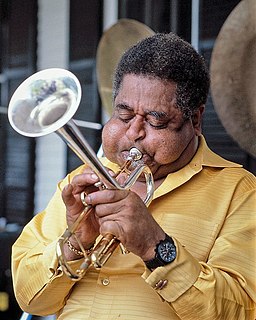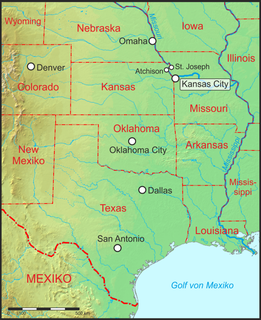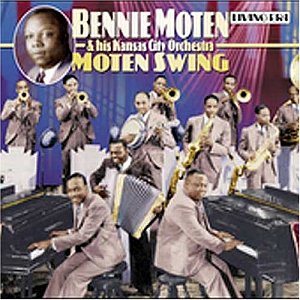Jazz is a music genre that originated in the African-American communities of New Orleans, Louisiana, United States, in the late 19th and early 20th centuries, with its roots in blues and ragtime. Since the 1920s Jazz Age, it has been recognized as a major form of musical expression in traditional and popular music, linked by the common bonds of African-American and European-American musical parentage. Jazz is characterized by swing and blue notes, complex chords, call and response vocals, polyrhythms and improvisation. Jazz has roots in West African cultural and musical expression, and in African-American music traditions.

Bebop or bop is a style of jazz developed in the early to mid-1940s in the United States, which features compositions characterized by a fast tempo, complex chord progressions with rapid chord changes and numerous changes of key, instrumental virtuosity, and improvisation based on a combination of harmonic structure, the use of scales and occasional references to the melody.

John Birks "Dizzy" Gillespie was an American jazz trumpeter, bandleader, composer, educator and singer. He was a trumpet virtuoso and improviser, building on the virtuoso style of Roy Eldridge but adding layers of harmonic and rhythmic complexity previously unheard in jazz. His combination of musicianship, showmanship, and wit made him a leading popularizer of the new music called bebop. His beret and horn-rimmed spectacles, scat singing, bent horn, pouched cheeks, and light-hearted personality provided some of bebop's most prominent symbols.

Louis Leo Prima was an American singer, songwriter, bandleader, and trumpeter. While rooted in New Orleans jazz, swing music, and jump blues, Prima touched on various genres throughout his career: he formed a seven-piece New Orleans-style jazz band in the late 1920s, fronted a swing combo in the 1930s and a big band group in the 1940s, helped to popularize jump blues in the late 1940s and early to mid 1950s, and performed frequently as a Vegas lounge act beginning in the 1950s.

Arthur Tatum Jr. was an American jazz pianist who is widely regarded as one of the greatest in his field. From early in his career, Tatum's technical ability was regarded by fellow musicians as extraordinary. Many pianists attempted to copy him; others questioned their own skills after encountering him, and some even switched instruments in response. In addition to being acclaimed for his virtuoso technique, Tatum extended the vocabulary and boundaries of jazz piano far beyond his initial stride influences, and established new ground in jazz through innovative use of reharmonization, voicing, and bitonality.
Swing music is a form of jazz that developed in the United States in the 1930s and 1940s. The name came from the emphasis on the off–beat, or weaker pulse. Swing bands usually featured soloists who would improvise on the melody over the arrangement. The danceable swing style of big bands and bandleaders such as Benny Goodman was the dominant form of American popular music from 1935 to 1946, known as the swing era. The verb "to swing" is also used as a term of praise for playing that has a strong groove or drive. Notable musicians of the swing era include Duke Ellington, Benny Goodman, Count Basie, Cab Calloway, Jimmy Dorsey, Tommy Dorsey, Woody Herman, Harry James, Lionel Hampton, Glenn Miller and Artie Shaw.

The Jazz Age was a period in the 1920s and 1930s in which jazz music and dance styles rapidly gained nationwide popularity in the United States. The Jazz Age's cultural repercussions were primarily felt in the United States, the birthplace of jazz. Originating in New Orleans as mainly sourced from culture of the diaspora, jazz played a significant part in wider cultural changes in this period, and its influence on popular culture continued long afterward. The Jazz Age is often referred to in conjunction with the Roaring Twenties, and in the United States it overlapped in significant cross-cultural ways with the Prohibition Era. The movement was largely affected by the introduction of radios nationwide. During this time, the Jazz Age was intertwined with the developing cultures of young people. The movement also helped start the beginning of the European Jazz movement. American author F. Scott Fitzgerald is widely credited with coining the term, first using it in his 1922 short story collection titled Tales of the Jazz Age.

Michael "Dodo" Marmarosa was an American jazz pianist, composer, and arranger.

52nd Street is a 1.9-mile (3.1 km)-long one-way street traveling west to east across Midtown Manhattan, New York City. A short section of it was known as the city's center of jazz performance from the 1930s to the 1950s.

Minton's Playhouse is a jazz club and bar located on the first floor of the Cecil Hotel at 210 West 118th Street in Harlem, Manhattan, New York City. It is a registered trademark of Housing and Services, Inc. a New York City nonprofit provider of supportive housing. The door to the actual club itself is at 206 West 118th Street where there is a small plaque. Minton's was founded by tenor saxophonist Henry Minton in 1938. Minton's is famous for its role in the development of modern jazz, also known as bebop, where in its jam sessions in the early 1940s, Thelonious Monk, Bud Powell, Kenny Clarke, Charlie Christian, Charlie Parker and Dizzy Gillespie pioneered the new music. Minton's thrived for three decades until its decline near the end of the 1960s, and its eventual closing in 1974. After being shuttered for more than 30 years, the newly remodeled club reopened its doors on May 19, 2006, under the name Uptown Lounge at Minton's Playhouse. However, the reopened club was closed again in 2010. Remodeling began again in 2012.

Oran Thaddeus "Hot Lips" Page was an American jazz trumpeter, singer, and bandleader. He was known as a scorching soloist and powerful vocalist.

Jazz at Lincoln Center is part of Lincoln Center for the Performing Arts in New York City. The organization was founded in 1987 and opened in October 2004. Wynton Marsalis is the artistic director and the leader of the Jazz at Lincoln Center Orchestra.

The Village Vanguard is a jazz club at Seventh Avenue South in Greenwich Village, New York City. The club was opened on February 22, 1935, by Max Gordon. Originally, the club presented folk music and beat poetry, but it became primarily a jazz music venue in 1957. It has hosted many highly renowned jazz musicians since then, and today is the oldest operating jazz club in New York City.
British jazz is a form of music derived from American jazz. It reached Britain through recordings and performers who visited the country while it was a relatively new genre, soon after the end of World War I. Jazz began to be played by British musicians from the 1930s and on a widespread basis in the 1940s, often within dance bands. From the late 1940s, British "modern jazz", highly influenced by American Dixieland jazz and bebop, began to emerge and was led by figures such as Kenny Ball, Chris Barber, John Keating, John Dankworth and Ronnie Scott, while Ken Colyer, George Webb and Humphrey Lyttelton emphasised New Orleans, Trad jazz. From the 1960s British jazz began to develop more individual characteristics and absorb a variety of influences, including British blues, as well as European and World music influences. A number of British musicians have gained international reputations, although this form of music has remained a minority interest within the UK itself.

Kansas City jazz is a style of jazz that developed in Kansas City, Missouri during the 1920s and 1930s, which marked the transition from the structured big band style to the musical improvisation style of Bebop. The hard-swinging, bluesy transition style is bracketed by Count Basie who in 1929 signed with the Bennie Moten's Kansas City Orchestra and Kansas City native Charlie Parker who ushered in the Bebop style in America. "While New Orleans was the birthplace of jazz, America's music grew up in Kansas City". Kansas City is known as one of the most popular "cradles of jazz". Other cities include New Orleans, Chicago, St. Louis, Pittsburgh, Philadelphia, and New York City. Kansas City was known for the organized musicians of the Local 627 A.F.M., which controlled a number of venues in the city.
South African jazz is the jazz of South Africa.

A jazz club is a venue where the primary entertainment is the performance of live jazz music, although some jazz clubs primarily focus on the study and/or promotion of jazz-music. Jazz clubs are usually a type of nightclub or bar, which is licensed to sell alcoholic beverages. Jazz clubs were in large rooms in the eras of Orchestral jazz and big band jazz, when bands were large and often augmented by a string section. Large rooms were also more common in the Swing era, because at that time, jazz was popular as a dance music, so the dancers needed space to move. With the transition to 1940s-era styles like Bebop and later styles such as soul jazz, small combos of musicians such as quartets and trios were mostly used, and the music became more of a music to listen to, rather than a form of dance music. As a result, smaller clubs with small stages became practical.
Clark Monroe's Uptown House, sometimes shortened to Monroe's Uptown House or simply Monroe's, was a nightclub in New York City. Along with Minton's Playhouse, it was one of the two principal clubs in the early history of bebop jazz.
Women in jazz have contributed throughout the many eras of jazz history, both as performers and as composers, songwriters and bandleaders. While women such as Billie Holiday and Ella Fitzgerald were famous for their jazz singing, women have achieved much less recognition for their contributions as composers, bandleaders and instrumental performers. Other notable jazz women include piano player Lil Hardin Armstrong and jazz songwriters Irene Higginbotham and Dorothy Fields.

"Moten Swing" is a 1932 jazz standard by Bennie Moten and his Kansas City Orchestra. It was an important jazz standard in the move towards a freer form of orchestral jazz and the development of Swing music. Moten and his Orchestra, which included Count Basie on piano, achieved much success with it, although the song is most associated with Basie's Count Basie Orchestra, who recorded it in 1940.















